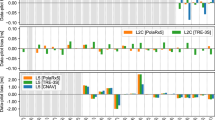Abstract
Different techniques have been developed for determining carrier phase ambiguities, ranging from float approximations to the efficient solution of the integer least square problem by the LAMBDA method. The focus so far was on double-differenced measurements. Practical implementations of the LAMBDA method lead to a residual probability of wrong fixing of the order one percent. For safety critical applications, this probability had to be reduced by eight orders of magnitude, which could be achieved by linear multi-frequency code–carrier combinations. Scenarios with single or no differences include biases due to orbit errors, satellite clock offsets, as well as residual code and phase biases. For this case, a linear combination of Galileo E1 and E5 code and carrier phase measurements with a wavelength of 3.285 m and a noise level of a few centimeters is derived. This ionosphere-free combination preserves the orbit and clock errors, and suppresses the E1 code multipath by 12.6 dB. Since integer decorrelation transformations, as used in the LAMBDA method, inflate biases, the number of such transformations must be limited, and applied in a judicious order. With a Galileo type constellation, this leads to a vertical standard deviation of ca. 20 cm, while keeping the probability of wrong fixing extremely low for code biases of 10 cm, and phase biases of 0.1 cycle, combined in a worst case.
Similar content being viewed by others
References
Betz J (2002) Binary offset carrier modulations for radionavigation. Navigation 48(4): 227–246
Blewitt G (1989) Carrier-phase ambiguity resolution for the Global Positioning System applied to geodetic baselines up to 2000 km. J Geophys Res 94: 10187–10203
Cao W, O’Keefe K, Cannon M (2007) Partial ambiguity fixing within multiple frequencies and systems. In: Proceedings of ION GNSS 2007, Fort Worth, USA, pp 312–323
Cao W, O’Keefe K, Cannon M (2008) Performance evaluation of GPS/Galileo multiple-frequency RTK positioning using a single- difference processor. In: Proceedings of ION GNSS 2008, Savannah, GA, USA, 9 p
Gabor M, Nerem S (2002) Satellite–satellite single difference phase bias calibration as applied to ambiguity resolution. Navigation 49(4): 223–242
Ge M, Gendt G, Rothacher M, Shi C, Liu J (2008) Resolution of GPS carrier-phase ambiguities in Precise Point Positioning (PPP) with daily observations. J Geod 82(7): 389–399
Golub G, van Loan C (1996) Matrix computations. 3. Johns Hopkins University Press, London
Henkel P, Gomez V, Günther C (2009) Modified LAMBDA for absolute carrier phase positioning in the presence of biases. In: Proceedings of Intern. Technical Meeting (ITM), Anaheim, USA, 10 p
Henkel P, Günther C (2008a) Joint L/C-band code–carrier linear combinations for Galileo. Intl. Journal of Navigation and Observation, Special Issue on Future GNSS Signals, 8 p
Henkel P, Günther C (2008b) Precise Point Positioning with multiple Galileo frequencies. In: Proceedings of the positioning, location and navigation symposium (PLANS), Monterey, USA, pp 592–599
Hwang P, Graw G, Bader J (1999) Enhanced differential GPS carrier-smoothed code processing using dual-frequency measurements. J Navig 46(2): 127–137
Kay S (1993) Fundamentals of statistical signal processing, vol I, estimation theory. Prentice Hall, Englewood Cliffs
Khanafseh S, Pervan B (2008) A new approach for calculating position domain integrity risk for cycle resolution in carrier phase navigation systems. In: Proceedings of ION/IEEE PLANS, Monterey, USA, 9 p, May 2008
McGraw G, Murphy T, Brenner M, Pullen S, Van Dierendonck AJ (2000) Development of the LAAS Accuracy Models. ION GPS 2000, Salt Lake City, USA
Niell A (1996) Global mapping functions for the atmosphere delay at radio wavelengths. J Geophys Res 101: 3227–3246
Salychev O, Schaffrin B (1992) New filter approaches for GPS/INS integration. In: Kumar M, Fell P (eds) Proceedings of the 6th international geodetic symposium on satellite positioning, vol II, pp 670–680, Columbus, Ohio
Teunissen P (1993) Least-squares estimation of the integer GPS ambiguities. Invited lecture, Section IV, Theory and Methodology, IAG General Meeting, Beijing
Teunissen P (1996) An analytical study of ambiguity decorrelation using dual frequency code and carrier phase. J Geod 70: 515–528
Teunissen P (1998) Success probability of integer GPS ambiguity rounding and bootstrapping. J Geod 72(10): 606–612
Teunissen P (2001) Integer estimation in the presence of biases. J Geod 75(7): 399–407
Tiberius C, de Jonge P (1995) Fast positioning using the LAMBDA method. In: Proceedings of DSNS-95, no. 30
Verhagen S (2004) Integer ambiguity validation: an open problem. GPS Solutions 8: 36–43
Verhagen S (2005) On the reliability of integer ambiguity resolution. Navigation: Journal of the Institute of Navigation, Vol. 52, No. 2.
Wang J, Satirapod C, Rizos C (2002) Stochastic assessment of GPS carrier phase measurements for precise relative positioning. J Geod 76(2): 95–104
Wang J, Stewart M, Tsakiri M (1998a) Stochastic modelling for GPS static baseline data processing. J Surv Eng USA 124: 171–181
Wang J, Stewart M, Tsakiri M (1998b) A discrimination test procedure for ambiguity resolution on the fly. J Geod 72(11): 644–653
Author information
Authors and Affiliations
Corresponding author
Rights and permissions
About this article
Cite this article
Henkel, P., Günther, C. Partial integer decorrelation: optimum trade-off between variance reduction and bias amplification. J Geod 84, 51–63 (2010). https://doi.org/10.1007/s00190-009-0343-0
Received:
Accepted:
Published:
Issue Date:
DOI: https://doi.org/10.1007/s00190-009-0343-0




